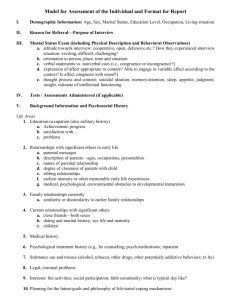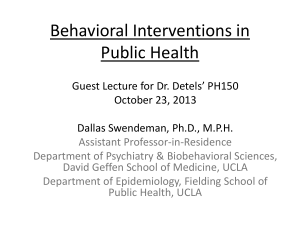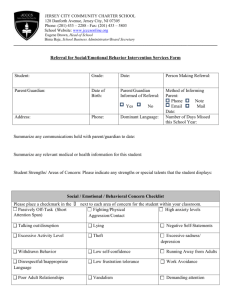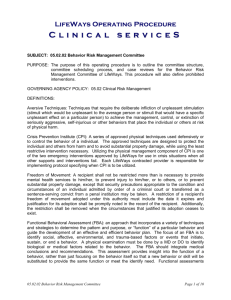Clinical serviceS
advertisement
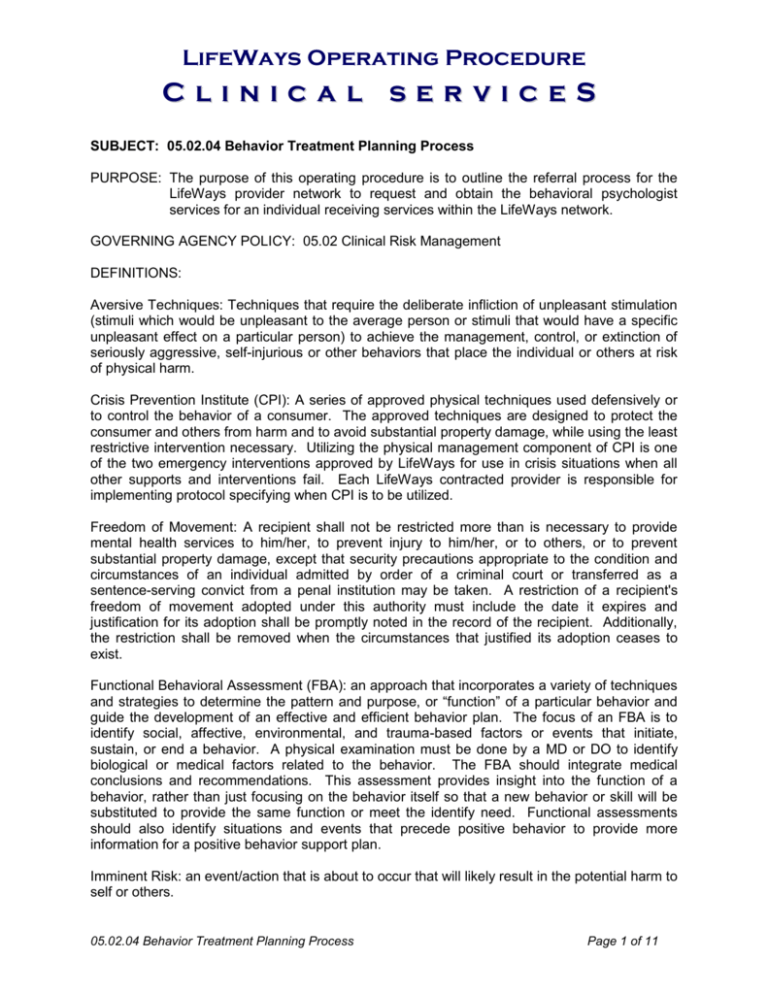
LifeWays Operating Procedure Clinical serviceS SUBJECT: 05.02.04 Behavior Treatment Planning Process PURPOSE: The purpose of this operating procedure is to outline the referral process for the LifeWays provider network to request and obtain the behavioral psychologist services for an individual receiving services within the LifeWays network. GOVERNING AGENCY POLICY: 05.02 Clinical Risk Management DEFINITIONS: Aversive Techniques: Techniques that require the deliberate infliction of unpleasant stimulation (stimuli which would be unpleasant to the average person or stimuli that would have a specific unpleasant effect on a particular person) to achieve the management, control, or extinction of seriously aggressive, self-injurious or other behaviors that place the individual or others at risk of physical harm. Crisis Prevention Institute (CPI): A series of approved physical techniques used defensively or to control the behavior of a consumer. The approved techniques are designed to protect the consumer and others from harm and to avoid substantial property damage, while using the least restrictive intervention necessary. Utilizing the physical management component of CPI is one of the two emergency interventions approved by LifeWays for use in crisis situations when all other supports and interventions fail. Each LifeWays contracted provider is responsible for implementing protocol specifying when CPI is to be utilized. Freedom of Movement: A recipient shall not be restricted more than is necessary to provide mental health services to him/her, to prevent injury to him/her, or to others, or to prevent substantial property damage, except that security precautions appropriate to the condition and circumstances of an individual admitted by order of a criminal court or transferred as a sentence-serving convict from a penal institution may be taken. A restriction of a recipient's freedom of movement adopted under this authority must include the date it expires and justification for its adoption shall be promptly noted in the record of the recipient. Additionally, the restriction shall be removed when the circumstances that justified its adoption ceases to exist. Functional Behavioral Assessment (FBA): an approach that incorporates a variety of techniques and strategies to determine the pattern and purpose, or “function” of a particular behavior and guide the development of an effective and efficient behavior plan. The focus of an FBA is to identify social, affective, environmental, and trauma-based factors or events that initiate, sustain, or end a behavior. A physical examination must be done by a MD or DO to identify biological or medical factors related to the behavior. The FBA should integrate medical conclusions and recommendations. This assessment provides insight into the function of a behavior, rather than just focusing on the behavior itself so that a new behavior or skill will be substituted to provide the same function or meet the identify need. Functional assessments should also identify situations and events that precede positive behavior to provide more information for a positive behavior support plan. Imminent Risk: an event/action that is about to occur that will likely result in the potential harm to self or others. 05.02.04 Behavior Treatment Planning Process Page 1 of 11 LifeWays Operating Procedure Clinical serviceS Intrusive Techniques: Techniques that encroach upon the bodily integrity or the personal space of the individual for the purpose of achieving management or control, of a seriously aggressive, self-injurious or other behavior that places the individual or others at risk of physical harm. Physical management: Techniques used by staff as an emergency intervention to restrict the movement of an individual by continued direct physical contact in spite of the individual’s resistance in order to prevent him or her from physically harming themselves or others. The term “physical management” does not include briefly holding an individual in order to comfort them or to demonstrate affection. Manually guiding down the hand/fists of an individual who is striking their own face repeatedly causing risk of harm IS considered physical management if they resist the physical contact and continues to try and strike. However, it is NOT physical management if the individual stops the behavior without resistance. When a caregiver places his hands on an individual’s arms to prevent him or her from running out the door and the individual resists and continues to try and get out the door, it IS considered physical management. However, if the individual no longer attempts to run out the door, it is NOT considered physical management. Physical management involving prone immobilization of an individual, as well as any physical management that restricts a person’s respiratory process, for behavioral control purposes is prohibited under any circumstances. Prone immobilization is extended physical management of an individual in a prone (face down) position, usually on the floor, where force is applied to their body in a manner that prevents him or her from moving out of the prone position. Positive Behavior Support: A set of research-based strategies used to increase opportunities for an enhanced quality of life and decrease seriously aggressive, self-injurious or other behaviors that place the individual or others at risk of physical harm by conducting a functional assessment, and teaching new skills and making changes in a person’s environment. Positive behavior support combines valued outcomes, behavioral, and biomedical science, validated procedures; and systems change to enhance quality of life and reduce behaviors such as selfinjury, aggression, property destruction, and pica. Positive Behavior Supports are most effective when they are implemented across all environments, such as home, school, work, and in the community. Proactive Strategies in a Culture of Gentleness: Strategies within a positive behavior support plan used to prevent seriously aggressive, self-injurious or other behaviors that place th individual or others at risk of physical harm from occurring, or for reducing their frequency, intensity, or duration. Supporting individuals in a culture of gentleness is an ongoing process that requires patience and consistency. As such, no precise strategy can be applied to all situations. Some examples of proactive strategies include: unconditional valuing, precursor behaviors, redirection, stimulus control, and validating feelings. Reactive Strategies in a Culture of Gentleness: Strategies within a Positive Behavior Support Plan used to respond when individuals begin feeling unsafe, insecure, anxious or frustrated. Some examples of reactive strategies include: reducing demanding interactions, increasing warm interactions, redirection, giving space, and blocking. 05.02.04 Behavior Treatment Planning Process Page 2 of 11 LifeWays Operating Procedure Clinical serviceS Request for Law Enforcement Intervention: Calling 911 and requesting law enforcement assistance as a result of an individual exhibiting a seriously aggressive, self-injurious or other behavior that places the individual or others at risk of physical harm. Law enforcement should be called for assistance only when: caregivers are unable to remove other individuals from the hazardous situation to assure their safety and protection, safe implementation of physical management is impractical, and/or approved physical management techniques have been attempted but have been unsuccessful in reducing or eliminating the imminent risk of harm to the individual or others. Involving law enforcement is one of the two emergency interventions approved by LW for use in a crisis situation when all other supportive interventions failed. Restraint – The use of a physical or mechanical device to restrict an individual’s movement at the order of a physician. The use of physical or mechanical devices used as restraint is prohibited except in a state-operated facility or a licensed hospital. This definition excludes: Anatomical or physical supports that are ordered by a physician, physical therapist or occupational therapist for the purpose of maintaining or improving an individual’s physical functioning. Protective devices, which are defined as devices or physical barriers to prevent the individual from causing serious self-injury associated with documented and frequent incidents of the behavior and which are incorporated in the written individual plan of service through a behavior treatment plan, which has been reviewed and approved by the Committee and received special consent from the individual or his/her legal representative. Medical restraint, i.e. the use of mechanical restraint or drug-induced restraint ordered by a physician or dentist to render the individual quiescent for medical or dental procedures. Medical restraint shall only be used as specified in the individual written plan of service for medical or dental procedures. Safety devices required by law, such as car seat belts or child car seats used while riding in vehicles. Restrictive Techniques: Techniques that will result in the limitation of the individual’s rights as specified in the Michigan Mental Health Code and the federal Balanced Budget Act. Examples of such techniques used for the purposes of management, control, or extinction of seriously aggressive, self-injurious or other behaviors that place the individual or others at risk of physical harm, include: limiting or prohibiting communication with others when that communication would be harmful to the individual; prohibiting unlimited access to food when that access would be harmful to the individual (excluding dietary restrictions for weight control or medical purposes); using the Craig (or veiled) bed, or any other limitation of the freedom of movement of an individual. Use of restrictive techniques require the review and approval of the Committee. Seclusion – The placement of an individual in a room alone where egress is prevented by any means, Seclusion is prohibited except in a hospital or center operated by the Michigan Department of Community Health (MDCH), a hospital licensed by the department, or a licensed child caring institution licensed under 1973 PA 116, MCL 722.111 to 722.128. Seclusion does not include involuntary confinement for legally mandated non-clinical purposes such as confining a person facing serious criminal charges or serving a criminal sentence in a locked room. 05.02.04 Behavior Treatment Planning Process Page 3 of 11 LifeWays Operating Procedure Clinical serviceS Therapeutic De-escalation – An intervention, the implementation of which is incorporated in the individualized written plan of service, wherein the recipient is placed in an area or room, accompanied by staff who shall therapeutically engage the recipient in behavioral de-escalation techniques and debriefing as to the cause and future prevention of the target behavior. Time Out – A voluntary response to the therapeutic suggestion to a recipient to remove him/herself from a stressful situation in order to prevent a potentially hazardous outcome. PROCEDURE EXPEDITED REFERRALS/CASE REVIEWS The BRMC recognizes the consequence of time relative to this service and has established a mechanism for the expedited review of behavior treatment plans. In the event a primary clinician, individual, or advocate, the Behavior Psychologist contacts the Committee Chairperson requesting an immediate review of a proposed behavior treatment plan. The Chairperson may decide to authorize the Behavior Treatment Planning Service without the requirement of the standard referral process. Expedited reviews must occur within 48 hours of the request. Recipient Rights must be informed of the proposed plan to assure that any potential rights issues are addressed prior to implementation of the plan. Upon approval, the plan may be implemented. All plans approved in this manner must be subject to full review at the next regular meeting of the Committee. NEW REFERRAL FOR BEHAVIOR TREATMENT PLAN Upon increase in behaviors, the Case Manager/Supports Coordinator, with the cooperation of the home staff, shall begin the following process in an effort to uncover and resolve the root cause of the behavior prior to referring for the Behavioral Psychologist service. 1. CSM begins the Behavioral Assessment Referral Checklist (Attachment 2), collecting as much documentation as possible throughout the completion of the Checklist for submission to Behavioral Psychologist with referral. 2. Simultaneously, the direct care home staff shall begin completing the Target Behavior Documentation Form (Attachment 3) every time the individual exhibits the targeted behavior. This is a part of the Checklist and must be done prior to a referral to the Behavioral Psychologist. a. Not intended to be a sheet per behavior. b. When the sheet is full, start another. 3. If the Checklist process is begun and, through the course of it, behaviors cease or subside and the treatment team believes the issue has resolved, document the recommendations and maintain documentation for future reference. However, start the Checklist process from the beginning should the behaviors resurface. 4. Once the Checklist is complete with substantial documentation and the target behaviors continue a referral may be made. Forward all documentation to Integro Behavioral Psychologists and enter an authorization request in LEO for a Behavior Treatment Planning Assessment. 05.02.04 Behavior Treatment Planning Process Page 4 of 11 LifeWays Operating Procedure Clinical serviceS The Behavioral Psychologist will conduct a behavioral assessment and will submit to the primary service provider (PSP) the findings and recommendations to reduce the behaviors. The assessment will include, but is not limited to, the following: A review of all documentation submitted by the PSP at referral A review of historical and current treatment information Observation A review of results of assessments performed to rule out physical, medical, and environmental causes of the problem behavior A functional assessment Any medical, psychological or other factors that the individual has which might put the individual at high risk of death, injury or trauma if subjected to intrusive or restrictive techniques Evidence of the kinds of positive behavioral supports or interventions, including their amount, scope, and duration that have been attempted and have proved to be unsuccessful. According to recommendations, the PSP will request an authorization for development and monitoring of the Behavior Treatment Plan at which point the Behavioral Psychologist will begin to develop a plan that will contain specific positive and preventive interventions to reduce the frequency, severity, and tendency for the target behavior(s) to occur. The Plan will also include: Evidence of continued efforts to find other options Peer Reviewed literature or practice guidelines that support the proposed intervention. A plan for monitoring and staff training to assure consistent implementation and documentation of the intervention. Emergency physical management or involving law enforcement will not be identified as an intervention available for treatment. Positive behavioral supports and proactive strategies will be utilized to the fullest extent possible to promote a culture that is supportive and protective of an individual’s rights and recovery. If the behavioral treatment plan proposes the use of restrictive or intrusive interventions, special consent is required from the consumer or guardian. The final Behavior Treatment Plan will be submitted to the Behavior Risk Management Committee (BRMC) for approval, at which point the Behavioral Psychologist will schedule an inservice to home and community staff. INTERVENTION MONITORING In order for the Behavioral Psychologist and BRMC to make educated and progressive decisions regarding individuals with a BTP it is critical that accurate and detailed data is collected and reported for each time the Behavior Treatment Plan restrictive/intrusive interventions are utilized in an effort to minimize a behavior. The following data shall be collected on individual plans through data sheet monitoring using the BTP Intervention Utilization Data Sheet (Attachment 4). Dates/times when interventions were used. Behavior that initiated the interventions. Observations about any events, settings, or factors that may have triggered the behavior. Settings where behavior and interventions occurred. 05.02.04 Behavior Treatment Planning Process Page 5 of 11 LifeWays Operating Procedure Clinical serviceS Most restrictive/intrusive intervention used for behavior. Description of positive behavioral supports used. Behaviors that resulted in termination of the interventions. Length of time of intervention Emergency Interventions To further promote a culture of gentleness and identify opportunities for improved services, it is expected that providers will facilitate a discussion within 24 hours of the behavior to identify what could have been done differently to prevent the use of physical management or involvement of law enforcement. The discussion must be documented on the Incident Report prior to being sent to the LifeWays Office of Recipeint Rights and must include: Staff development and training and supervisory guidance to reduce the use of these interventions. Treatment Plan recommendations if needed, including review, modifications, or development of a Behavior Treatment Plan. Network-wide emergency interventions data will be aggregated for reporting quarterly and annually to the Quality Management Council. The Quality Management Team will include this as a part of the Agency’s Quality Assessment Performance Improvement Program. REFERENCE MDCH/CMHSP Managed Mental Health Supports and Services Contract FY 12 Attachment C6.8.3.1 MDCH Companion Guide to the Technical Requirement for Behavior Treatment Plan Review Committees MDCH Guide to Prevention & Positive Behavior Supports in a Culture of Gentleness Procedure 05-02.02 Behavior Risk Management Committee ATTACHMENTS/FORMS Attachment 1: Behavior Treatment Plan Referral Process Flow Attachment 2: Behavioral Assessment Referral Checklist Attachment 3: Target Behavior Documentation Form Attachment 4: BTP Intervention Utilization Data Sheet HISTORY Reviewed: Revised: 05.02.04 Behavior Treatment Planning Process Page 6 of 11 Attachment 1 Behavior Treatment Plan Referral Process Flow 05.02.04 Behavior Treatment Planning Process Page 7 of 11 Attachment 1 Behavior Treatment Plan Referral Process Flow 05.02.04 Behavior Treatment Planning Process Page 8 of 11 Attachment 1 BEHAVIORAL ASSESSMENT REFERRAL CHECKLIST Individual Name: _____________________________________ LEO Number: ___________________ Case Manager/Supports Coord. Name/Provider Name: ______________________________________ Collection Start Date: _____________________ Collection End Date: ___________________________ Referral Sent to Beh Psych: Yes No If Yes, Date: ______________________________ If No, Why Not: _______________________________________________________________________ ___________________________________________________________________________________ Before making a referral for Behavior Treatment Planning Services, please complete the following and, if applicable, attach the documentation, which outlines the results: A medical assessment has been completed to rule out physical issues? i.e., bowel impactions, urinary tract infections, issues of physical or oral pain, seizures, etc. Date of Service ____________________ The consumer has had a recent medication evaluation by their Primary Care Physician (i.e. side effects, ineffectiveness, etc)? Date of Service _____________________________________________ Was there a change in medication? ___________________________________________________ __________________________________________________________________________________ The consumer has had a recent medication evaluation by their Psychiatrist (i.e. side effects, ineffectiveness, etc)? Date of Service ___________________________________________________ Was there a change in medication? ___________________________________________________ __________________________________________________________________________________ Are there any existing medical issues, which trigger behaviors or sensitivity to surroundings? For example, loss of hearing/eyesight, seizure disorders, dental issues, common cold, etc _____________ __________________________________________________________________________________ __________________________________________________________________________________ The treatment team has reviewed changes in the consumer's environment, which may trigger behaviors? For example, natural supports, roommates, placement, routine, outings, staff, diet, services, bed/dresser/toys, etc. _________________________________________________________________ __________________________________________________________________________________ __________________________________________________________________________________ The Case Manager/Supports Coordinator has revised the IPOS objectives and/or interventions (do not include restrictive interventions) to address behaviors? IPOS and ABC Charts MUST accompany this referral. ____________________________________________________________________________ __________________________________________________________________________________ __________________________________________________________________________________ The Crisis Plan been revised? _______________________________________________________ __________________________________________________________________________________ Has the consumer had sensory activities integrated into their daily routine to rule out potential sensory issues? Yes No ___________________________________________________________ __________________________________________________________________________________ __________________________________________________________________________________ Was an emergency BRMC consult needed/requested? If so, please attach outcomes of that session BTP Referral Checklist Form Yes No 11/29/11 Attachment 3 Target Behavior Documentation ABC Chart Individual Name: _______________________ Date What was occurring prior to the behavior? Data Collection Form LEO Number: _____________________ What was the actual behavior? What occurred to stop the behavior? 11/29/2011 Staff initials Behavior Treatment Plan Attachment 4 Intervention Utilization Data Sheet Data Sheet Period: From Date: ________________ To Date: __________________ Positive behavioral supports used to avoid behavior Behavior that terminated intervention Location Legend: DR = Dining Room; LR = Living Room/Common area; K = Kitchen; PBR = Personal Bed Room; OBR = Other Bed Room; C = Community; V = Vehicle; O = Other (please define) Inter Duration Most restrictive inter used for behavior Inter Location Emergency Physical Mgt What precipitated behavior? Intrusive/ Restrictive Behavior causing intervention (inter) Behavior Location Time Date Individual Name: __________________________ Individual Number: ________________________ Primary Provider Org: _______________ Case Manager: __________________ Home: ______________________
